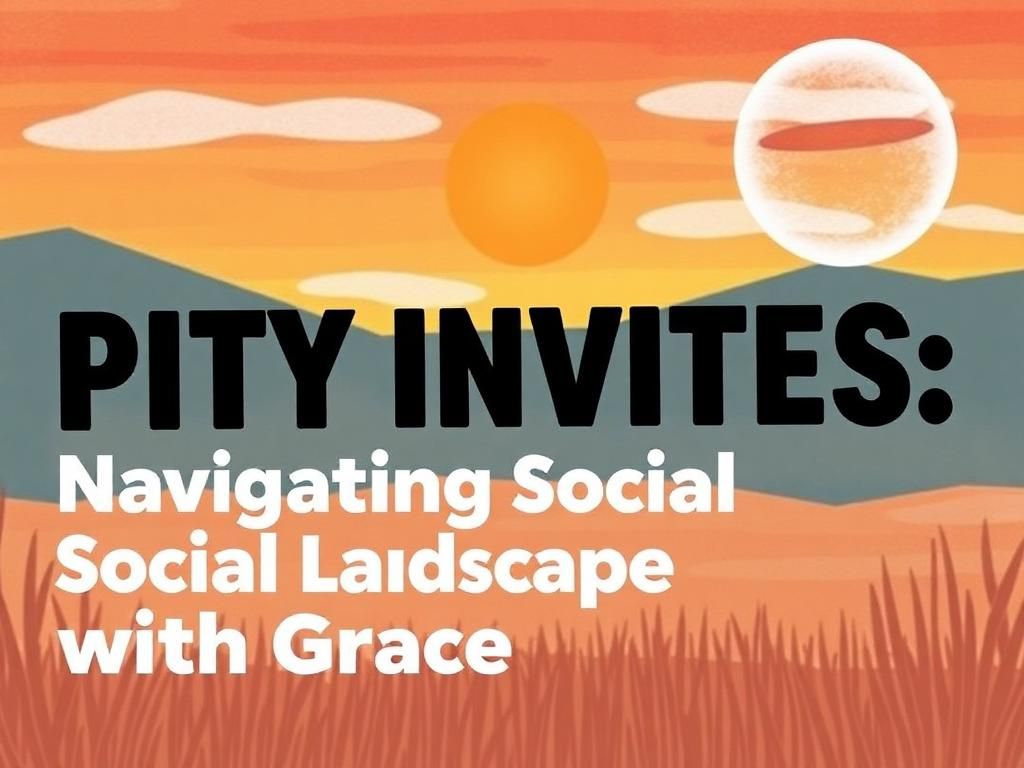Recognizing and understanding the nuances of social interactions is essential for fostering healthy relationships. One concept that often surfaces in these dynamics is the pity invite. A pity invite occurs when someone extends an invitation to another person out of a sense of obligation or sympathy, rather than genuine desire for their presence. This phenomenon can complicate social gatherings and lead to misinterpretations of relationships. Exploring pity invites helps in recognizing subtle cues and improving communication among peers. This article will uncover the nature, impact, and effective navigation of pity invites while promoting deeper connections.
Understanding the Concept of Pity Invitations
What is a Pity Invite?
A pity invite is typically characterized by an invitation made at the behest of sympathy or politeness rather than a genuine wish for someone’s company. Common situations where pity invites occur include:
1. **Social Gatherings:** Inviting a friend to a party, even when unsure if they genuinely want to join.
2. **Workplace Events:** Asking a colleague to participate in a team outing primarily because they seem lonely.
3. **Family Occasions:** Extending an invitation to a family member you don’t see often—out of obligation rather than connection.
Understanding these contexts can provide insight into social dynamics, allowing us to navigate them more effectively.
Psychological Perspectives
Several underlying psychological factors explain why individuals offer pity invites:
– **Empathy and Kindness:** People often express pity invites based on an empathetic urge to bring happiness or avoid solitude for others.
– **Desire to Avoid Hurting Feelings:** Some may feel obligated to invite someone to prevent rejection or embarrassment, even if the desire isn’t mutual.
– **Social Obligation and Politeness:** Many adhere to societal norms by extending invitations, even when their genuine enthusiasm may be lacking.
These psychological motivations can contribute to the complexities of interpersonal relationships and social obligations.
Cultural Differences in Pity Invites
Cultural perceptions significantly impact how pity invites are perceived or extended. For example:
– **Western Perspectives:** In many Western cultures, the focus often lies on individualism. Pity invites might be less common, as authenticity and direct communication are often prioritized.
– **Eastern Perspectives:** Conversely, in many Eastern societies, where collectivism prevails, social harmony is emphasized, potentially leading to more frequent instances of pity invites.
These cultural contrasts highlight the variety in social norms surrounding invitations and the tacit expectations in different societies.
Recognizing Pity Invites in Social Situations
Signs of a Pity Invite
Identifying pity invites requires keen awareness of verbal and non-verbal cues:
– **Verbal Cues:** Phrases like “You should come!” often come with hesitation, implying reluctance rather than eagerness.
– **Non-Verbal Cues:** Body language, such as crossed arms or lack of eye contact, may indicate that the invite is more an act of courtesy than true enthusiasm.
Being attuned to these signs can help individuals navigate the subtleties of social interactions more effectively.
Examples of Common Scenarios
Pity invites can manifest in various contexts:
– **Social Gatherings:** Invitations to events where the inviter feels obligated—like birthday parties where the invitee is included out of pity.
– **Workplace Events:** Team outings where someone is invited solely to avoid leaving them out, despite the inviter’s uncertainty about their interest.
– **Casual Outings with Friends:** Inviting someone along to a dinner or movie whom one doesn’t genuinely want to spend time with, sometimes leading to feelings of rejection.
Impact of Pity Invites on Relationships
Emotional Effects on the Invited Person
Receiving an invite that feels like a pity invite can have significant emotional repercussions:
– **Feelings of Rejection and Low Self-Esteem:** Knowing an invite comes from obligation rather than genuine interest can lead to a sense of inadequacy.
– **Potential for Resentment or Frustration:** Over time, consistent pity invites can foster feelings of resentment towards those extending the invitations.
These emotional ramifications emphasize the need for sincere interactions among peers.
Consequences for the Inviter
Offering pity invites can have social implications for the inviter:
– **Social Implications:** Individuals offering pity invites may feel uncomfortable or awkward, sensing the insincerity of their approach.
– **Potential Damage to Friendships and Trust:** Long-term patterns can erode trust and weaken relationships, as recipients sense lack of authenticity.
Navigating these relationships requires deliberation and self-awareness.
Navigating Pity Invitations
How to Handle Being on the Receiving End
When faced with a pity invite, responding gracefully is key:
– **Assessing Personal Feelings and Reactions:** Reflecting on one’s emotional responses can help in deciding whether to accept or decline the invitation.
– **Choosing Whether to Attend or Decline:** If the invite feels insincere, it’s perfectly acceptable to politely decline, which can also foster better communication of expectations.
These strategies can facilitate respectful social interactions.
Offering Genuine Invitations
Creating heartfelt invitations requires a thoughtful approach:
– **Open Communication and Authenticity:** Being upfront about one’s reasons for inviting someone fosters trust and transparency.
– **Framing the Invite in a Positive Light:** Emphasizing the joy of their company can transform a pity invite into a truly heartwarming gesture.
Effective communication can significantly enrich interpersonal connections.
Alternatives to Pity Invites
Building Genuine Connections
Fostering authentic relationships involves thoughtful planning on both sides:
– **Suggestions for Fostering Meaningful Relationships:** Engage in activities that align with mutual interests, ensuring that all parties feel valued and included.
– **Tips for Inclusive Planning and Inviting:** Consider everyone’s preferences and feelings when planning events, encouraging open dialogues about social gatherings.
Striving for meaningful connections enhances overall social satisfaction.
Creating Empowering Social Environments
Empowering environments can uplift everyone involved:
– **Encouraging All Participants to Engage:** Initiatives such as icebreakers can foster involvement from all members, minimizing feelings of isolation.
– **Ensuring Everyone Feels Included and Valued:** Prioritizing inclusivity in social settings, by actively inviting each person’s perspective, can transform dynamics.
Creating such environments contributes to healthier social landscapes.
Conclusion
Understanding the intricacies of pity invites is critical to navigating today’s social landscape effectively. Recognizing their implications, both for the invitee and inviter, helps in fostering more authentic interactions. Encouraging readers to evaluate their own invitation habits may contribute to healthier social dynamics in their communities.
Additional Resources
1. Books and articles related to social psychology and relationships can provide further insight. For example, visit the [American Psychological Association](https://www.apa.org) for reputable resources.
2. Online forums and communities can offer social skills development opportunities.
3. Experts’ opinions can guide readers toward creating meaningful social interactions.
| Key Elements | Examples | Effects |
|---|---|---|
| Pity Invites | Invitations from obligation | Feelings of inadequacy |
| Psychological Perspectives | Empathy, social obligation | Complicated relationships |
| Signs to Recognize | Hesitant invites | Awareness in interactions |
| Emotional Effects | Low self-esteem, resentment | Impact on relationships |
| Alternatives | Genuine connections | Healthier social dynamics |
FAQs
What is a pity invite?
A pity invite is an invitation extended out of sympathy or obligation rather than genuine interest in someone’s presence.
How can I tell if I receive a pity invite?
Look for signs such as hesitant language or non-verbal cues indicating discomfort or insincerity from the inviter.
Are pity invites common?
Yes, they can occur in various social contexts, including gatherings, workplace events, and among friends and family.
What should I do if I suspect I’m giving a pity invite?
Reflect on your motivations and strive to offer genuine invitations by focusing on authentic communication and enthusiasm.
How can I decline a pity invite politely?
You can express gratitude for the invitation while politely stating that you cannot attend, ensuring your response feels gracious and respectful.
What are some constructive alternatives to pity invites?
Foster genuine connections by ensuring shared interests, engaging inclusive planning, and creating inviting social environments.
Can pity invites harm relationships?
Yes, offering pity invites can erode trust and create feelings of inadequacy or resentment on both sides, complicating social interactions.
How do cultural differences impact pity invites?
Cultural norms can shape the prevalence and perception of pity invites, with some cultures emphasizing authenticity over obligation, while others prioritize social harmony.
What resources can I explore for improving my social skills?
Consider reading articles on social psychology, visiting reputable websites like the American Psychological Association, or joining community forums focused on interpersonal communication.
Is it advisable to offer pity invites?
While they often come from a caring place, it is generally better to seek authentic connections, encouraging invitations that reflect genuine interest and enthusiasm.


